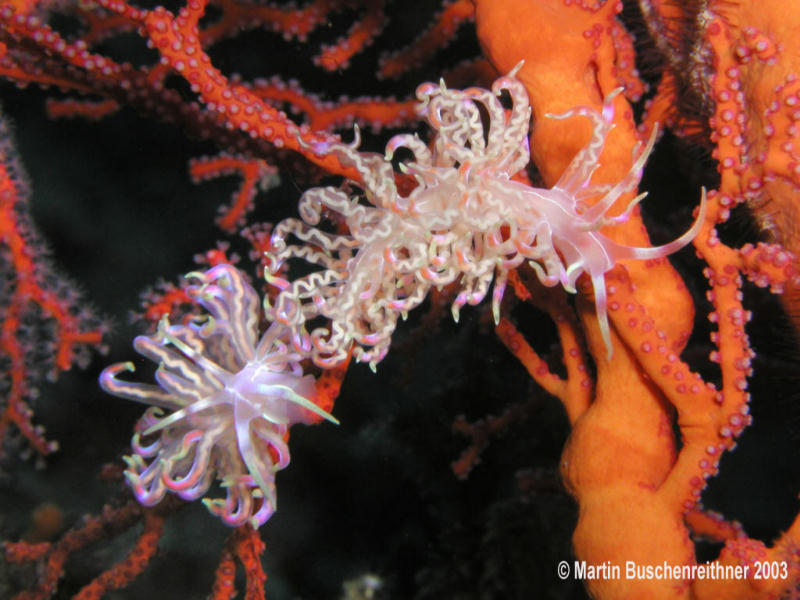 |
Phyllodesmium sp.
Photo courtesy of Martin BuschenreithnerLipah Bay, Ahmed, Bali, Indonesia
Phyllodesmium sp. undescribed
New species of nudibranchs are being found daily around the world by sharp eyed divers. This gorgeous Phyllodesmium has been known for sometime now, but apparently hasn't hit the top of the priority list of any of the active taxonomists describing new species today. It was featured as BOW on Week 257 and is quite possibly the same as Bob Bolland's Phyllodesmium sp. 7 .
I wish we had more information about this species, but to me it looks very similar to the species Bill Rudman refers to as Phyllodesmium sp. 5 , because of the white lines on the body. See also Nishina Masayoshi's excellent images of the same animal on the red sea fan and associated egg mass . It could however be Rudman's Phyllodesmium sp. 6 because of the coloration of the cerata. In any event this is a perfect example of a genus that displays very wide variations in body color, and where we will never be sure until someone takes the time to gather up a bunch of specimens, from across the known geographic distribution of the species and look at the internal anatomy to determine if this lovely creature it new at all, and if there is more than one species here, or just variable coloration. It would be real easy to vote for variation in color as it clear from the differences between the two animals in Martin's photo here that co-occurring individuals can certainly look different.
Martin took this fine shot at Lipah Bay, Bali, Indonesia, while Bill's Sp. 5 is known from the Solomons and Japan, and Species 6, or this coloration, is known only from Japan. Although this distribution doesn't rule out a single very variable species, one important differentiation is that Martin's animal is closer to numero 5 in that it's rhinophores are smooth, those of Rudman's species 6, having have small pointed white papillae, over their surface. Okay, so sp 5 and sp 6 are likely different.
An important attribute is separating members of the genus Phyllodesmium is there prey. Most species feed specifically on only one soft coral species. Also, some sequester microscopic zooxanthellae in branches of their digestive glands, while other don't. Our species here is always found on the red sea fan, Melithaea . We don't know what Rudman's species 6 lives on, but both fit the group without zooxanthellae, as have unbranched digestive glands in their cerata. Examples of Phyllodesmium species that sequester zooxanthellae are P. crypticum and P. magnum .
Next week we'll take a look at another interesting and possibly new Phyllodesmium Martin has come across.
Danville, Calif
Jul. 2003

|
Martin Buschenreithner lives in Mautem, Austria and has been diving since 1988 with a trip to the Red Sea. Martin and his wife were first fascinated with all the colorful fishes but gradually shifted their interests to the rare and unusal animals such as Frogfishes, Ghostpipe Fish, Seahoreses, Shrimps, Crabs, and Nudies of course. Martin considers the best area for such animals to be the Lembeh Strait in Sulawesi, Indonesia.
Martin has taken over 20,000 photographs in 10 years with MM MMX10 and MM II EX. Since October of 2001 he has almost exclusively been shooting digital first with the Olympus C-4040 Z and more recently with the Olympus C-5050Z.
Send Martin email at ma.busch@utanet.at |
Taxonomic information courtesy of:

David W. Behrens
Author:
Pacific Coast Nudibranchs
Send Dave mail at dave@seachallengers.com
|
